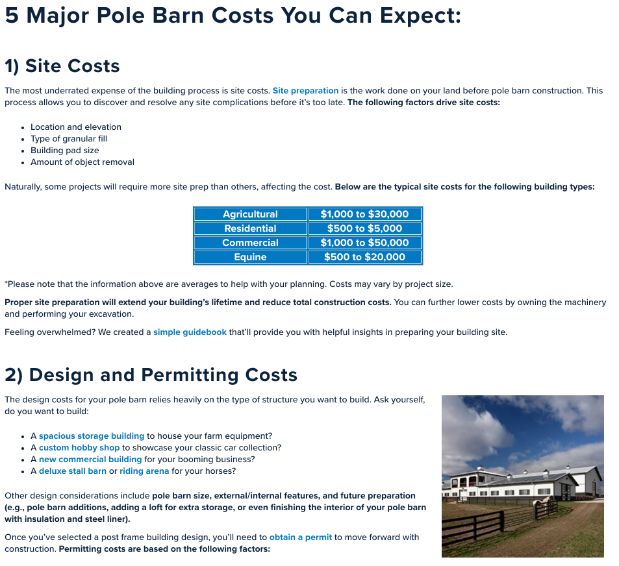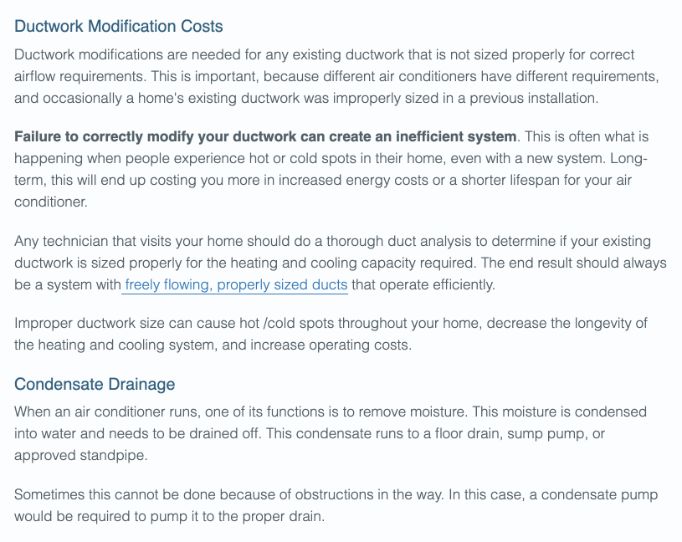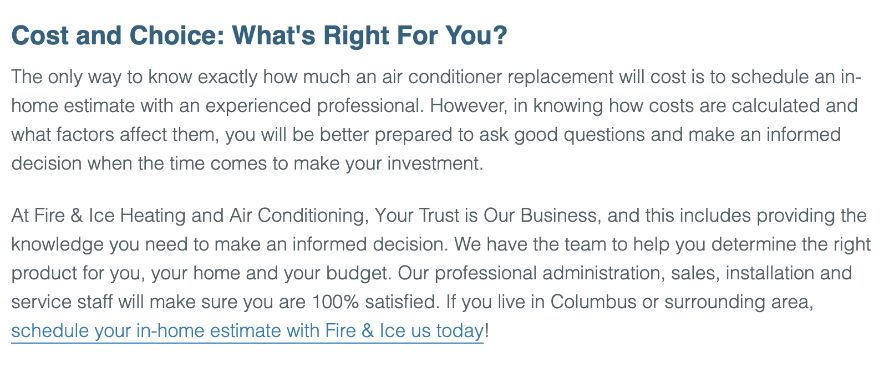Subscribe now and get the latest podcast releases delivered straight to your inbox.
How to Write An Effective Cost Article for Your Business

Nov 3, 2020

When you’re researching an important purchase decision, few things can be more frustrating than not being able to find helpful answers to your questions.
And if there is one question that I’ve heard people complain about the lack of quality answers, it’s those related to how much a product or service costs.
Regardless of what product or service it is we’re talking about, you’ll often find tons of content on its benefits, on how it compares to other options, which of its kind are the best, and all kinds of other questions.
But when we look on a business's websites for how much it costs, we’re met with the equivalent of a shrug emoji ( ¯\_(ツ)_/¯ ) and a button to contact the company for a quote.
What in the actual frick?
Why do I need to call you to get an estimate? Why can’t you give me an idea so I can decide if that phone call is even worth my time?
Why does this lack of transparency around cost still persist in many industries and by many businesses?
For over half a decade, I’ve been working with content managers to develop their content marketing strategies.
Arguably the most important part of their strategy is to eliminate any confusion their audience may have about the products and services their company sells.
This is especially true when talking about cost.
From B2B to B2C, national to local, products to services, all of these businesses have their own unique offerings.
And while most would argue that they have unique prospects and customers, I can attest that the majority of their prospects have similar questions they need answers to before buying anything.
If you’ve followed IMPACT for any amount of time, you’ve undoubtedly heard us talk about IMPACT partner Marcus Sheridan’s book, They Ask, You Answer.
If so, you’ve probably also heard us mention The Big 5 blog topics.
If you haven’t, let me summarize for you real quick.
The Big 5 are questions nearly every buyer, regardless of industry, want answered before they make a purchase. These are questions that help them decide which solution is the best fit for the problem they’re experiencing.
Of The Big 5, easily the most important topic you could possibly address on your website is cost.
People have a lot of questions about the various costs of your products and services.
So why not answer their questions about cost?
Why should you address cost on your website?
I’m glad you asked. Even our case study clients that now rave about their cost articles were once skeptical about addressing cost.
But, there are three major concerns most businesses have when it comes to writing about cost on their website.
(If you’re already on board with writing a cost article, go ahead and skip down to “How to write the perfect cost article” section)
1. Addressing cost builds trust with readers
At the top of this article, I mentioned how frustrating it can be when people struggle to find the answers to their questions.
This is especially true of cost questions. It often feels like the only way to get answers to cost questions is to speak directly with salespeople, but this can also lead to people feeling like they’re being pushed to close a deal when they’re just trying to gather information.
When we write blog articles explaining cost and put pricing pages on our websites, we give prospects the honesty and transparency they’re looking for.
Giving answers to questions without asking for anything in return goes a long way towards building trust with people.
And when people view our organization as trustworthy, they’re more likely to want to buy from us.
2. Help people understand the many factors that influence cost
There are a lot of factors that can influence the final price of your product or service. Writing an article that gives an exact figure is next to impossible.
But here’s the thing: When people are researching how much something costs, many understand there’s not a one-size solution for all (although some may believe there’s a one-price-fits-all solution). What they’re really wanting to know are what those factors are.
Take IMPACT client FBi Buildings, a pole barn builder, for example.
Let’s say you wanted a new pole barn on your property to store all of your farm equipment. You have a rough idea of what you’d like, but you’re not sure of the size you’d need, the design of the building, what permits you’d need, or what finishing touches you’d like.
To help you narrow your options, you’d want to know what factors could be the difference between an affordable pole barn and one completely out of your league, and you’d most likely want to know these things before engaging with a salesperson.
FBi Buildings answered the question with “How Much Does a Pole Barn Cost?” which has now been read by over 35,000 pole barn shoppers (who knew pole barns were so popular?).
And all they had to do was break down the top five factors that impact the cost of a pole barn.

3. If you don’t address cost, someone else will
Frankly, if you don’t write a cost article, someone else will.
While many businesses continue to shy away from tough questions, a growing number of companies recognize the value of answering their audience’s pressing questions.
When I first got started creating content, it was often hard to find cost articles in clients’ industries. The door for ranking quickly and high up on Google was wide open for cost content.
I could often get people to write a halfway decent answer and watch them skyrocket to the top of Google search results in a matter of weeks.
However, we’ve been promoting cost articles for several years now, and many businesses have listened.
It’s no longer enough to simply be willing to address cost, now you have to have a fantastic answer to the query to have a chance at ranking.
(Don’t worry, we’ll talk about the best practices for writing cost articles shortly.)
In the meantime, please don’t get discouraged from writing a cost article, even if the market is saturated with answers. These articles aren’t just meant for driving traffic to your website (although that is a huge bonus).
In fact, they’re best used in the sales process as pieces of assignment selling, whereby you proactively send answers to questions you know your prospects will bring up shortly.
There are different types of “cost” articles
Another really important consideration when it comes to cost articles is to not get stuck on that word, “cost.”
Most people think when I say to write cost articles that I’m only asking them to write topics like How much does a La-Z-Boy Recliner Cost or Cost of Intermodal Transportation Services (who hasn’t searched for both of those queries this week?).
But cost isn’t just one question people have.
It’s a cluster of related topics.
For example, when I worked as a content manager for a sleep clinic, I wrote an article addressing the cost of sleep apnea tests (written in 2014, it’s still on the first page of Google, but please don’t judge it by today’s standards. Like I said, you used to be able to get away with so-so answers).
But what I discovered was that what people really wanted to know about the cost of sleep apnea testing was if their insurance would cover it.
That’s why I followed my cost article up with one addressing insurance coverage for sleep tests.
Most clients I work with have to write several cost articles targeting queries dealing with insurance, warranties, fines, hidden fees, and several others.
How to write the perfect cost article
Okay, now that we’ve covered all the reasons you’re going to write a cost article and discussed the different types, we can get down to business on how to write a cost article.
To really put buyer’s worries at ease, there are important considerations to take into account when framing a cost article.
Let’s dive into them.
1. Consider all questions that need to be addressed
You’re probably tired of hearing me say, “there are many factors that influence the final price.”
I feel the same way, but I say it so much because that’s really the meat and potatoes of your blog article, and here is where we put that into practice.
Once you pick which product or service to write about, I want you to list out those various factors.
If it’s a product, these factors may include:
- Base rates for the product
- Accessories, features, and add-ons
- Labor included to build/manufacture/create the product
- Cost of installation
- Cost of shipping
- Package deals
- Any other factors that influence the cost of your particular products (take some time to make sure you include as much information as possible).
If it’s a service, these factors may include:
- Type of service
- Time to complete service
- Cost of materials
- Cost of labor
- Installation costs
- Additional rates, fees, taxes
Once you have the topic clearly fleshed out, and the points you wish to make, you’re ready to start writing your first cost article.
2. Hook your reader with an intro that resonates
The intro is where you hook the reader. If you can quickly show them that you know who they are, that you understand their problem, and that you can help them solve their problem, they may just keep on reading.
Fail to connect with readers in the intro, and there’s a slim chance they’ll read the rest of the article.
Fire & Ice Heating and Air Conditioning’s cost article, Cost of an Air Conditioner Replacement is a great example.

If you were a homeowner whose A/C unit just stopped working during the peak of summer, you’d probably be freaking out a bit.
Naturally, your main worry is how much it will cost to replace.
This intro simply connects with the fear and worry you have, acknowledges how big of a decision it is, and promises to cover every factor that affects the final price of an A/C system.
For more tips on how to write powerful introductions (and really, any aspect of a blog article, check out our Blogging Tips for Content Marketers.
3. Dive into the details with the body of your article
The body of the article is where you put together the bulk of the information you’ll present.
The body should be split up into clear sections to make the content easy to scan. Therefore, you’ll want to use headers to give people signposts as to what you’ll be discussing for the next handful of paragraphs.
For cost articles, we already talked about how you’ll want to address each factor that impacts the cost.
An easy way to structure most of your blog article is to use those major factors as your headers, then give the explanation beneath.
If those sections need to be broken down further, great, use additional subheadings to continue breaking complex topics down into digestible chunks.
Let’s look at just a small section of the HVAC replacement article.

If I asked you, what are the major factors discussed in the screenshot above, what would your/ answer be?
Yeah, you’d probably say, “ductwork modifications and condensate drainage.”
That’s because the sections are clearly labeled using headers and the copy following each header relates specifically to that factor. I’d also encourage you to visit the entire page and scroll through the article.
Ask yourself, “do I feel like this article will answer how much an HVAC system costs to replace?”
While scrolling, pay attention to the headers, the paragraphs, the bolded text, the links, the images, and bullet points. All of these elements give cues to help you decide whether or not the article is worth reading in full.
So what do you think? Does the article pass the scroll test? Would you go back to the top and read the article in its entirety, or would you go back to Google in search of a better answer?
4. Give them next steps with your outro
The intro convinced people to give your article a shot, and the body showcased your expertise by breaking down the complex factors into easy to understand sections.
By now, readers should have a solid understanding of the different determinants that can affect cost. So what do you do with an outro?
The outro should serve two major functions:
- Give them a real idea of the cost
- Let them know what they need to do next
Blog article outros are not like the conclusions of your college essays. They’re not meant to just summarize everything you just learned. Instead, any blog outro should address at least one of these three questions your reader is asking themselves:
- So, what?
- Why now?
- What’s next?
For cost articles, the best question you can help answer for them is “what’s next?”
Now that they have a firmer idea of the general costs associated with their problem, what is the next step they should take? Are there other pieces of content they should read? Should they reach out to businesses to get quotes or schedule consultations?
Help your readers understand their next best move, and if you’re able to help them further, make it known to them how you can continue to be of service.
Let’s look one last time at the A/C replacement article to see how they wrapped up their blog.

It’s a pretty simple conclusion, really. First, they admit it’s hard to pinpoint an exact figure because there are so many influences.
However, they also let readers know that at least now they’re better armed at asking the right questions during a sales call and they should be better equipped to make informed decisions.
Finally, they give a sales pitch of their own. The let readers in the Columbus, Ohio area know that if they need further help, they can schedule an in-home estimate with them.
5. Write your title
Once you have finished your article, it’s time to refine your title. Often, the best titles are those that closely match the query people use to search or one that mirrors their intent.
You can do keyword research using tools like SEMrush, play around with Google search autocomplete, or simply ask your sales team how people bring it up then use tools to refine that choice.
Then, craft a title that directly reflects what they want to know. Consider how people will search, and what they'll want to find.
Your title could end up as simple as: “How Much Does [SERVICE X] Cost? A Breakdown of Common Prices and Plans.”
The reason you should title articles this way is because this will be how most people type the cost inquiry into a Google search bar.
Some search terms may vary, but most of the time, if someone wants to know the cost of a product, they’re going to enter: “How much Does X Cost?”
In the second part of the title, consider two things: other ways they may phrase their search and what they'd like to see.
We do this because we have up to 70 characters we can use for a title before it gets cut off on a results page. With this extra space, we can help provide more context into what we’ll be covering in the article.
For example, our friends at Sheffield Metals wrote an article answering how much metal roofs cost.
For their title, they went with What is the Cost of a Metal Roof? Factors, Considerations, & Examples.
The first part of the title goes after the main question verbatim.
The second part helps to give a sneak preview of what’s inside the article —the factors that influence price, the considerations you’ll need to weigh, and even some examples to help paint a clear picture.
6. Optimize your URL
Another small, but important piece of your article is the URL.
Crafting your own custom URL is a best practice because it’s something search engines will look for when determining the validity of your article.
I prefer URLs that are shortened versions of the title. I believe they’re best when they’re reduced down to their essential elements while still giving context to what the page is about.
According to a Moz article written by Rand Fishkin, search engines don’t have trouble processing longer URLs (unless they get a bit too long over 100 characters), but shorter URLs are easier for people to read, understand, as well as copy and paste to share on social or embed in articles.
For the metal roofing article, the final URL is not: .../what-is-the-cost-of-a-metal-roof-factors-considerations-and-examples.
Instead, it’s boiled down to: /learning-center/metal-roof-cost-price
If you’re not sure what to remove from your title to craft a winning URL, here’s a few things you can easily remove:
- Prepositions, pronouns, dates, numbers, adjectives, and conjunctions can often be taken out for brevity.
In the end, you simply want a short, sweet URL that still captures the essence of your article while cutting down on all the fluff.
7. Write an effective meta-description
Once again, we want to have control over what appears on a search engine results page rather than leave it up to your blog tool.
A lot of businesses neglect to create unique meta descriptions because they don’t have the SEO impact that other elements of an article have. However, what meta descriptions lack in direct SEO value, they more than make up for in search click-through rates (an indirect SEO factor).
On a search engine results page, you pretty much have three elements to base your decision of which page to click on: titles, URLs, and meta descriptions.
Think of meta descriptions like the inside jacket of a hardcover book. You picked up the book because of the title or the artwork, but the short copy on the flap helps you decide whether to ring it up or put it back on the shelf.
That’s the job of the meta description: to entice you to click on the article by giving you an idea of what to expect if you do.
We’ve found through many trials that there’s a pretty easy way to create meta descriptions that improve click-through rates.
Try using a simple question and tease-the-answer format.
You start with a question that aligns with the inquiry a searcher is asking themselves, and you follow up with a snippet of an answer.
First, they see their query mirrored back at them. And any keywords they use in their search that you have in your meta description will appear in bold (to make it leap off the page).
You’re limited on the number of characters you can use in a meta description. While meta description lengths can vary, most will appear at 160 characters or less. So anticipate getting truncated around 160 characters.
So, what does this look like? Here is an example of an effective meta description for a cost article:
“Are you looking for answers on how much ghost hunters cost? In this article, we discuss the various factors that influence the price of hunting ghosts such as...”
If you counted, that title is 160 characters exactly; right around the number before Google will truncate it.
I rephrased the question, included my keywords, mentioned what the article will discuss, and made it seem as if they almost got the answer, but they’re now going to have to click on our article to get the full explanation.
What else should I be writing about?
Alright, so that was a LOT of information to take in about cost articles.
The reason I wrote so extensively on this topic is because these articles are the most important pieces of content you can create for your business.
I can’t stress enough how valuable it is for you to tackle these topics and tackle them well.
If you're wishing you had even more examples of cost articles to review, check out my article, 12 top-ranking cost article examples. I've broken the examples down for both B2B and B2C as well as products and services.
Once you write your amazingly informative cost article, you’ll probably wonder what comes next, what other pieces of content should you create?
Getting back to The Big 5 blog topics, we have more articles detailing why you should write each of these articles and the nuances to consider for each.
- How to write about your competitors
- How to write a product review
- How to write a problems article
- How to write a comparison article
And to take things beyond The Big 5, here is a list of other important topics to address on your blog and across your website, 17 Business Blog Topics.
Good luck on your cost articles! If you want more help creating pages that discuss pricing and costs, we have an article dedicated to examples of pricing pages that you should check out.


Order Your Copy of Marcus Sheridan's New Book — Endless Customers!